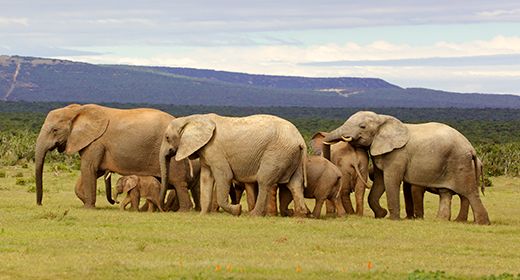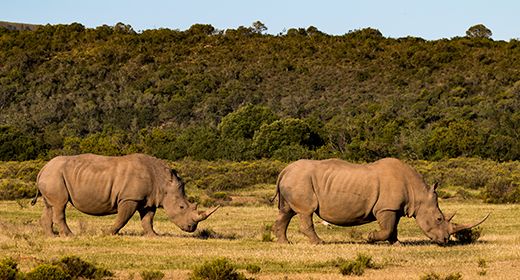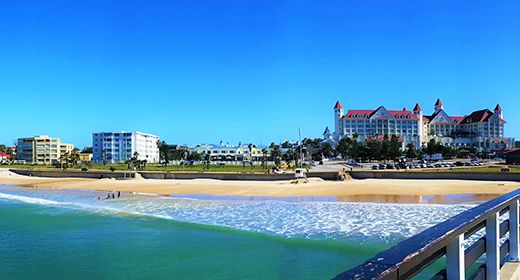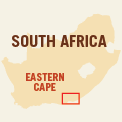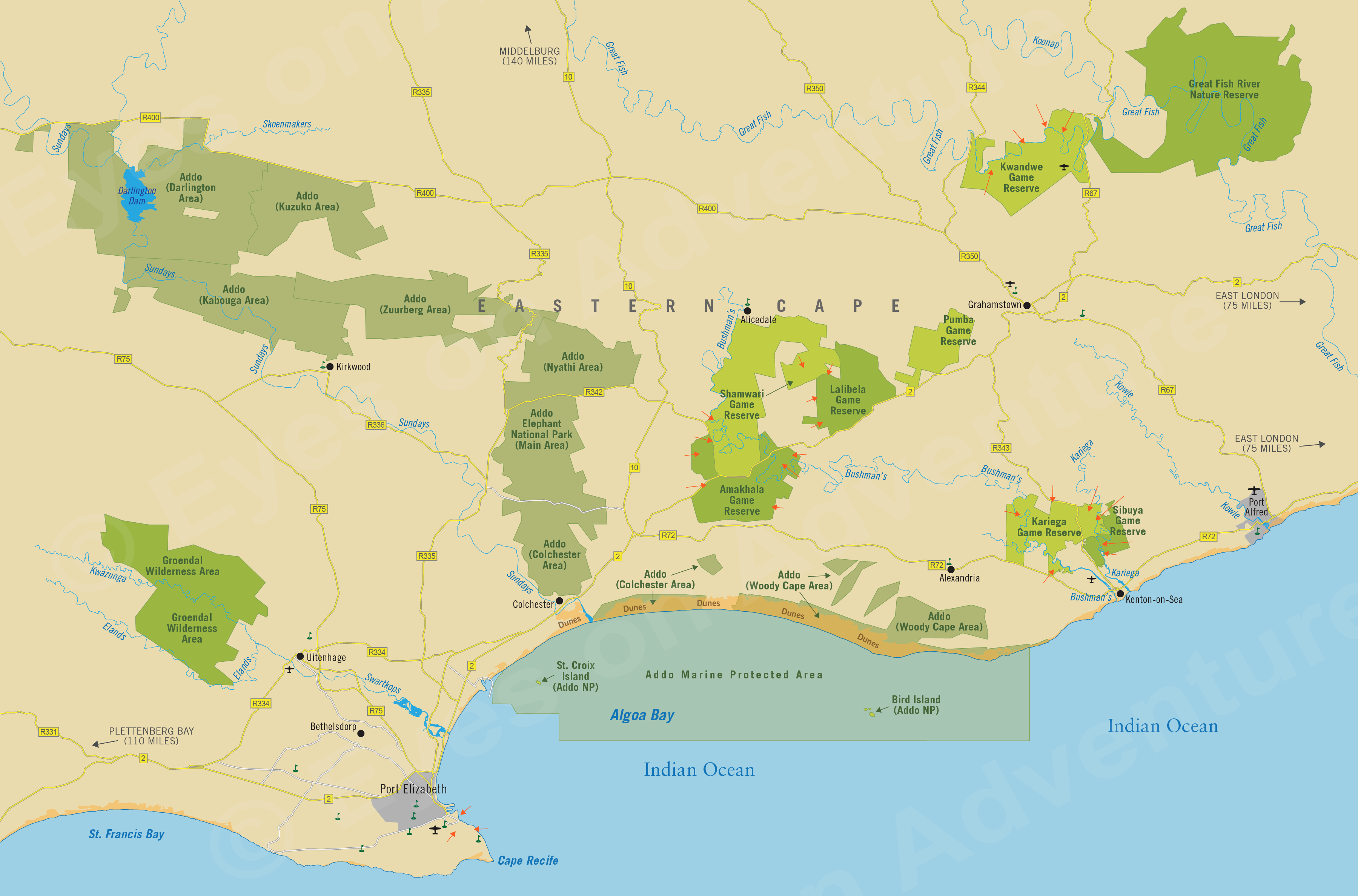Eastern Cape
(incl. Addo, Shamwari, Kwandwe, Port Elizabeth, Lalibela, Kariega, Sibuya, Amakhala)
Region Links: Cape Peninsula, Cape Town, Cape West Coast, Cape Winelands, Eastern Cape, Garden Route, Gauteng Province, Johannesburg, Kruger Park & Lowveld, Kruger Private Reserves, KwaZulu-Natal, Madikwe, Overberg & Whale Coast, Pilanesberg & Sun City, Sabi Sand Reserve
Highlights
- See the Big Five in a variety of malaria-free game reserves
- Great to combine with a self-drive tour of the Garden Route
- Family-friendly region with plenty to see and do
- Addo National Park is one of the best places in Africa to see elephants
EOA Recommends: Gorah Elephant Camp, Great Fish River Lodge, Kichaka Private Game Lodge, Long Lee Manor, The Windermere
The Eastern Cape is South Africa's most diverse region, yet is mostly overlooked as a tourist destination, giving it an 'off-the-beaten-path' charm.
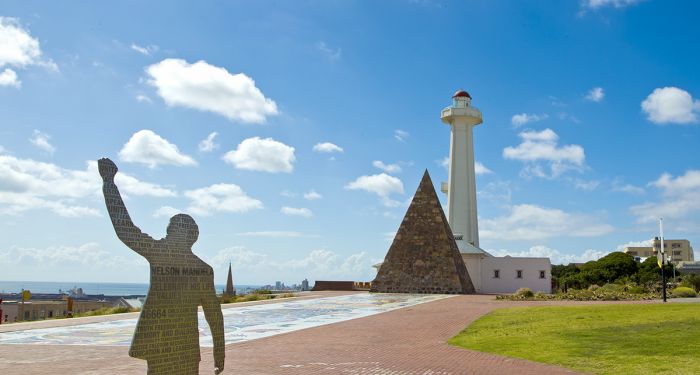
The Donkin Monument and Lighthouse in Port Elizabeth.
Port Elizabeth, known locally as PE, is the gateway to this region and is often used as the start or end point for self-drive tours of the region, including the well-known Garden Route.
The region offers numerous malaria-free wildlife reserves and hundreds of miles of mostly undeveloped coastline with pristine and uncrowded beaches, abundant marine wildlife, sand dune fields, and natural beauty.
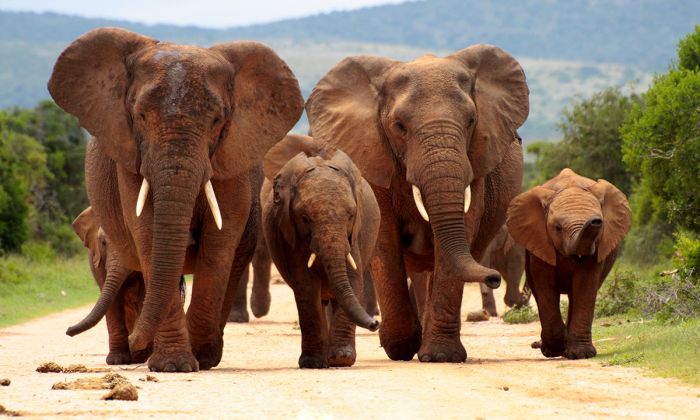
Elephants in Addo Elephant National Park.
Inland about a one-hour drive from PE are some of the country's most significant game reserves, including Addo Elephant National Park, where elephant viewing is virtually guaranteed and The Big Five (lion, leopard, rhino, buffalo, elephant) are also present.
Other rewarding wildlife reserves close to PE include Shamwari, Lalibela, Amakhala, Kariega, Kwandwe, and the Great Fish River Nature Reserve.
Numerous small towns, including Grahamstown are worth a visit for their historical and cultural significance.
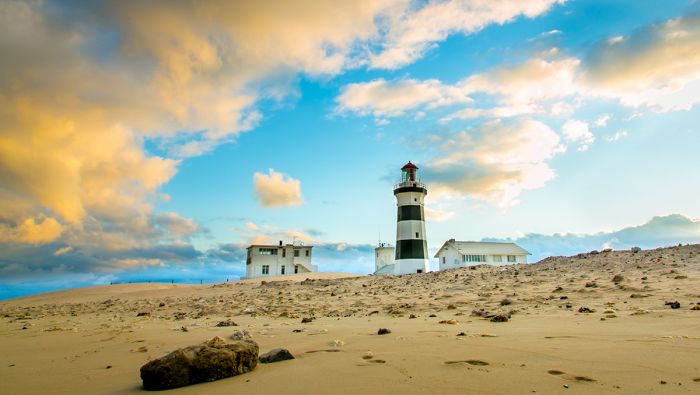
The lighthouse at Cape Recife, just south of Port Elizabeth.
Read More...
Addo Elephant Park, Amakhala, Eastern Cape Reserves, Grahamstown, Kariega, Kwandwe, Lalibela, Port Elizabeth, Pumba, Shamwari, Sibuya
Port Elizabeth
Port Elizabeth (known as PE) is the largest city in the Eastern Cape and is affectionately known as "the Friendly City". PE offers some attractions for tourists, but it is mostly visited as the gateway (via its airport) to the region. For those with some time, PE is certainly worth a day or two to explore.
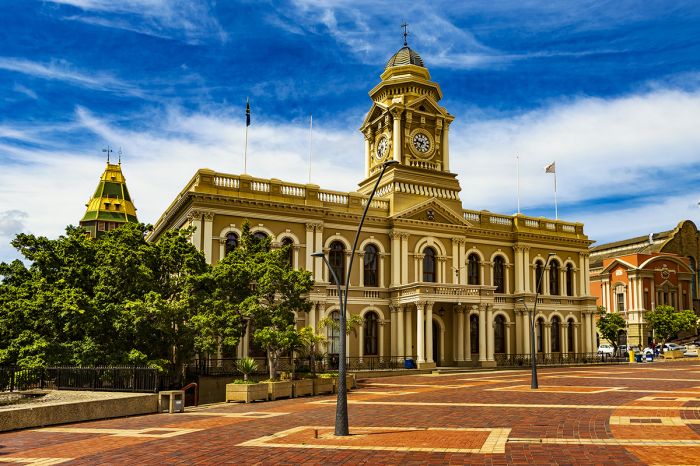
City Hall in Market Square, Port Elizabeth.
The town is a good base for day visits to the various sections of Addo Elephant National Park. For those planning to visit the wildlife reserves further to the east, such as Shamwari or Kwandwe, it's best to spend the night in PE so you can make it to your lodge in time for the afternoon activity.
Visitors to PE will find plenty to see and do. There are numerous good beaches in and around the town, including Hobie, Humewood, King's, and Pollock. Those wanting to try surfing will find easier waves here than at Jeffrey's Bay, to the west. Sardinia Bay Beach, to the south of town is secluded and located in a Marine Protected Area and offers excellent scuba-diving.
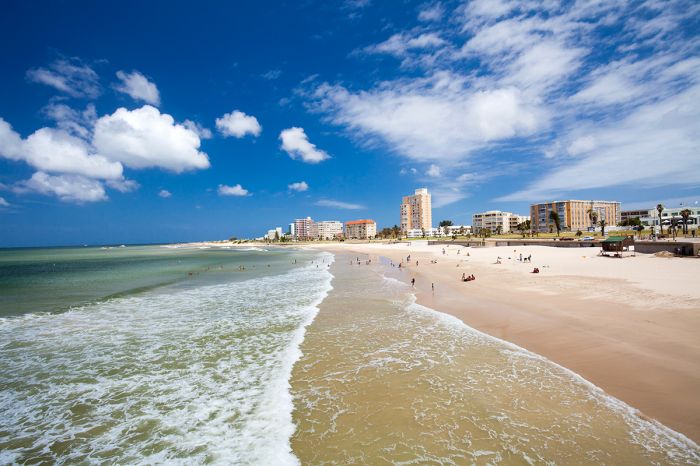
Hobie Beach in Port Elizabeth.
The older section of town, called Central, offers well-preserved historic buildings and there are good restaurants and some night life too. Golfers will enjoy Humewood Golf Course, one of South Africa's best.
A must-see while in PE is the Route 67 Art and Heritage Walk. Launched in 2011, this local art project celebrates the 67 years that Nelson Mandela dedicated to the freedom struggle in South Africa. The walking route includes 67 artworks created by local artists, each one positioned on a giant step, starting in the city center and ending at the Donkin Reserve and the old lighthouse, which overlook the harbor.
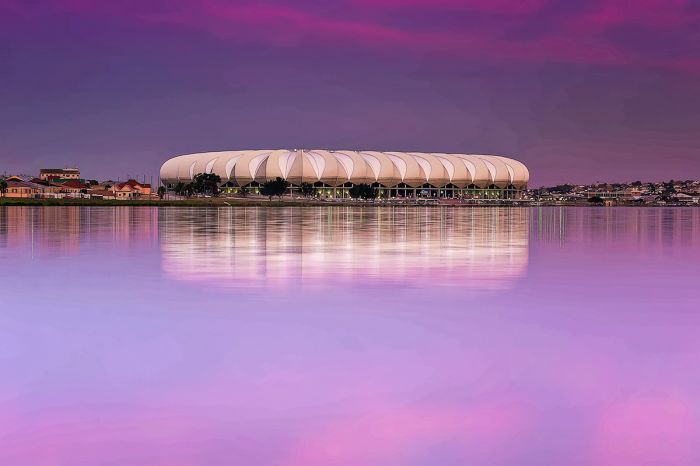
Nelson Mandela Bay Stadium in Port Elizabeth.
Addo Elephant National Park
Addo dates back to 1921 when it was created as a municipal reserve to protect Africa's southernmost population of elephants. The reserve was granted national park status in 1931 when the last 11 elephants in the region were all that remained. The original portion of the park (Main Area) was fully fenced in 1954 to keep the elephants from venturing into the surrounding farmland.
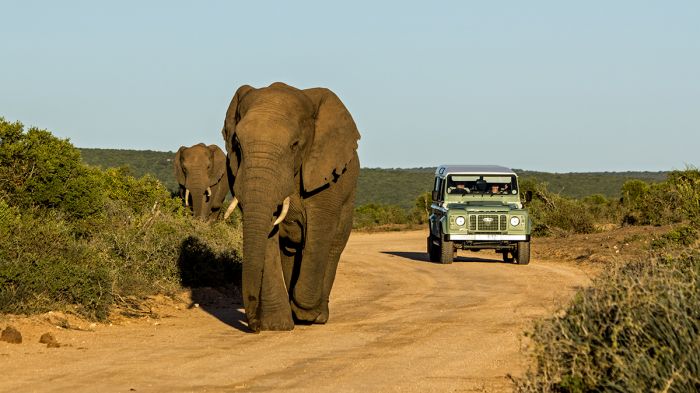
A big elephant bull in Addo Elephant National Park.
Today Addo is South Africa's third-largest national park and offers a malaria-free, Big Five safari experience. Its 77-square-mile (200-sq-km) Main and Colchester Areas offer by far the best game viewing and are home to around 700 elephants. This is one of the best places on the continent to see very relaxed elephants up close.
Other wildlife that can be seen in the Main / Colchester Areas are home to buffalo, lion, leopard (if you're lucky), cheetah, spotted hyena, black-backed jackal, black rhino, greater kudu, eland, red hartebeest, zebra, bushbuck, ostrich, and numerous other herbivores, small predators, and diverse bird life.
The amazing coastal dune fields are protected by Addo's Colchester and Woody Cape Areas.
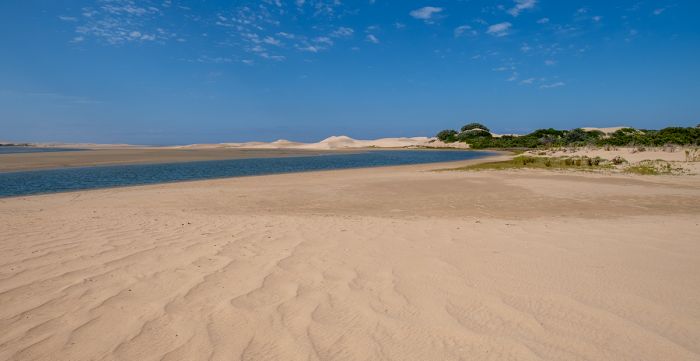
Pristine coastal dunes in Addo's Colchester Area.
Although Addo was originally created to protect a single species, in 1997 a proposal was accepted to expand the park to incorporate other reserves and areas to the south, northwest, and offshore.
The Greater Addo Elephant National Park now protects an enormous 6 564 square miles (17 000 sq kms) of diverse habitat from the arid Karoo down to the coast and even offshore. Although the various sections of the park are currently divided by roads, railways and fences, the long-term goal is to remove these barriers and connect all land sections by corridors.
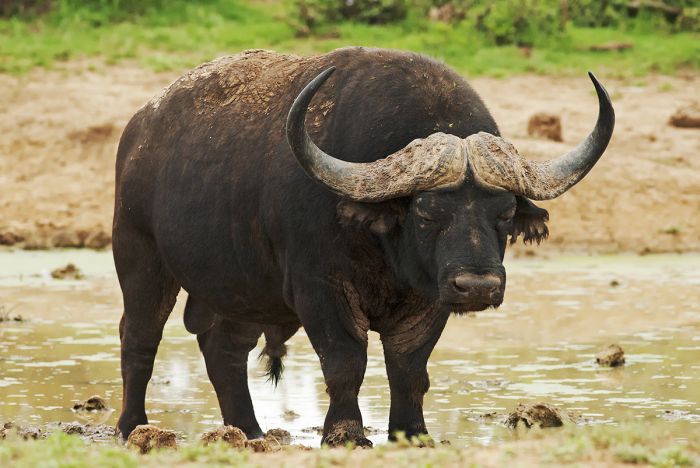
A huge buffalo in Addo.
The mountainous Zuurberg and Kabouga Areas are particularly beautiful and scenic, with excellent hiking and horseback trails, but does not host a great variety of wildlife.
The Nyathi Area is separated from the Main Area by a major road and railway line, but elephants and other wildlife are fairly abundant here. The Kuzuko Area consists of privately-owned land that has been leased long-term to SANParks for incorporation into Addo.
In 2018, a family of 28 elephants were relocated from the Main Area to the Darlington Area, Addo's northernmost section high in the Karoo. Lion, greater kudu, red hartebeest, and various other antelopes occur naturally here and there are plans to reintroduce buffalo and wild dogs to Darlington.
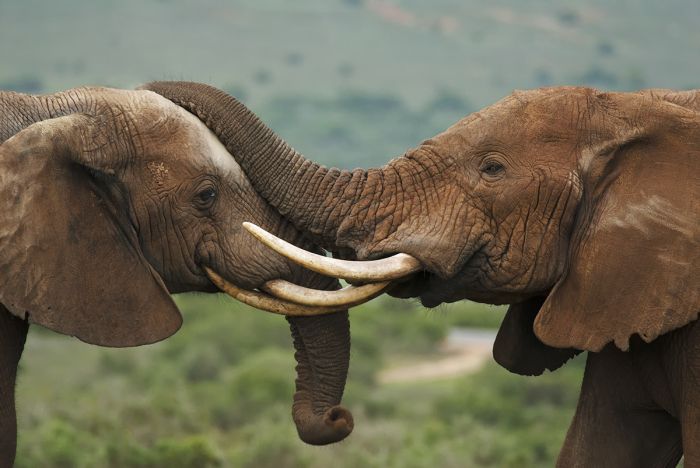
Elephants greeting in Addo.
The marine protected area includes Bird Island, which was incorporated to control abalone poachers and protect vulnerable bird species, including the Cape Gannet, which use the island as a nesting site. St. Croix Island is home to 22 000 African penguins, the largest breeding colony of this species on the planet.
The park does not offer many accommodations at this time, but Gorah Elephant Camp is a very good option and there are several SANParks rest camps, which are self-catering. Self-driving is permitted throughout most of the park's sections. Horseback safaris are available as well.
The variety of Addo's various protected areas is far beyond that of any other African national park. Five of South Africa's seven terrestrial biomes are found in Addo, including towering 340-foot-high (100-metesr) coastal sand dunes, montane forest, coastal fynbos, Karoo plains, and offshore breeding islands used by endangered bird species.
Addo is also home to the rare and near-endemic flightless dung beetle.
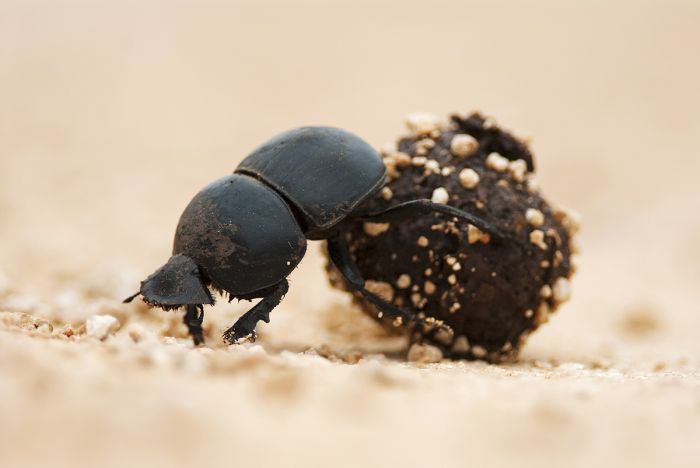
The flightless dung beetle in Addo Elephant National Park.
Eastern Cape private Reserves
While Addo National Park is ideal for self-drive explorations, the region also offers numerous private, Big Five wildlife reserves with all-inclusive accommodation and high-quality, malaria-free safaris.
Shamwari and Kwandwe are considered the best destinations in the region for a wildlife safari. The other private reserves offering good safaris include Amakhala, Lalibela, Pumba, Kariega, and Sibuya.
A safari in one of the private reserves, combined with a self-drive tour along the coast towards Cape Town, makes for a diverse adventure.
Kwandwe Game Reserve
Kwandwe spans over 85 square miles (220 sq kms) of pristine wilderness along the Great Fish river, which flows through 30 kms of the reserve. The reserve is arguably the best of the Eastern Cape's safari destinations, with high-end accommodations consisting of only two lodges and three private villas, all managed by one of Africa's top safari operators.
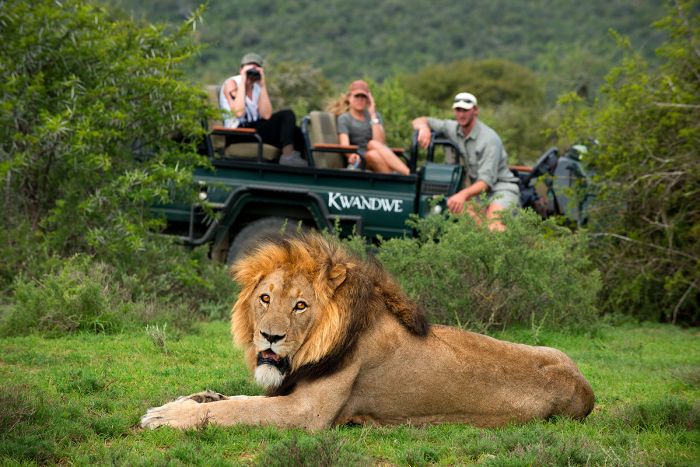
Game drive in the Kwandwe Game Reserve.
The Big Five (lion, leopard, elephant, rhino, buffalo) are all here, including both white rhino and black rhino, plus other lesser known species like the black wildebeest, aardvark, aardwolf, and blue crane (Kwandwe means 'place of the blue crane' in the Xhosa language). Other wildlife includes cheetah, spotted hyena, brown hyena, giraffe, zebra, greater kudu, oryx, caracal, springbok, and many more.
Activities center on game viewing, with game drives in open vehicles and boating on the Great Fish river. Walking safaris and fishing are optional activities. Family and child-friendly safaris are a specialty at Kwandwe.
Kwandwe is a 30-minute drive from Grahamstown, which can be reached from Port Elizabeth via short flight or 90-minute drive. Daily flights from Port Elizabeth directly to Kwandwe's private airstrip are the easiest way to reach the reserve.
Shamwari Game Reserve
Only a 90-minute drive from Port Elizabeth, Shamwari is another one of South Africa's wildlife conservation success stories. Once a collection of unprofitable farms, the 97-square-mile (250-sq-km) private reserve was created in 1992 and today offers a malaria-free, Big Five safari experience with a number of excellent, all-inclusive lodges. Game drives and walking safaris are on offer and the focus is on a fully immersed nature experience.
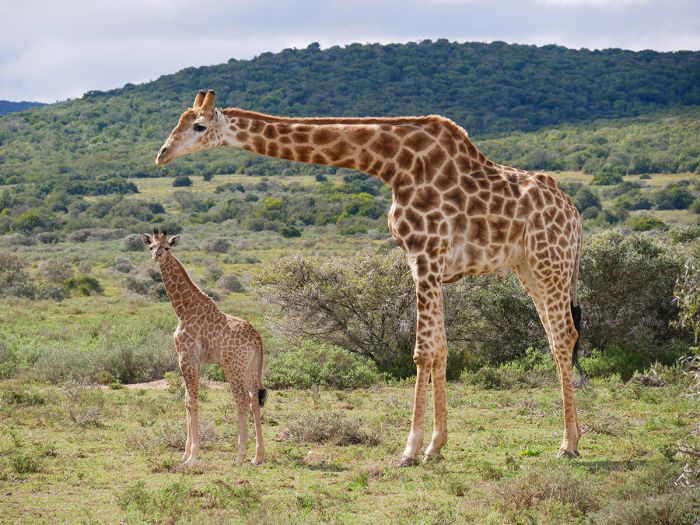
Giraffe and her calf in the Shamwari Game Reserve.
Part of the Shamwari Reserve has been set aside for the Born Free Big Cat Sanctuaries (there are two in the reserve). Born Free rescues lions and leopards from zoos, circuses and other private locations around the world and gives them a place to live out their lives in expansive, natural environments, as they cannot be safely returned to the wild. Their main purpose is educational and they are worth a visit if you are staying in the reserve.
Amakhala Game Reserve
The 33-square-mile (85-sq-km) Amakhala Game Reserve is located on prior farmland owned by five families that are direct descendants of the original British settlers here. The reserve offers excellent lodges with fully-inclusive activities, Big Five game viewing, walking safaris, boating and canoeing on the Bushman's river, and horseback safaris. Day safaris are also permitted using local operators.
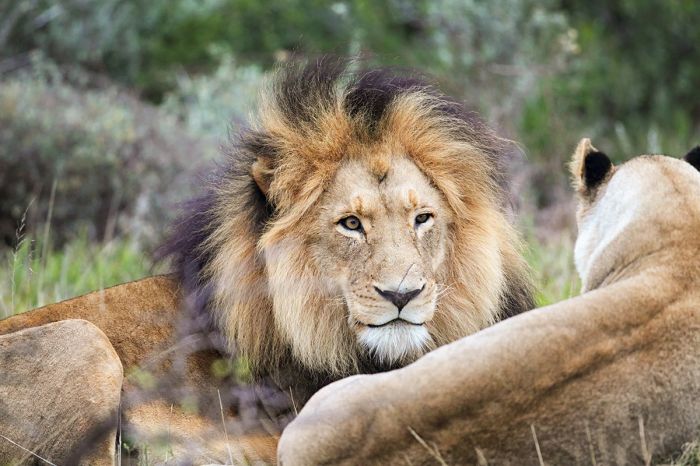
Lions in the Amakhala Game Reserve.
Lalibela Game Reserve
Lalibela is another small (41 sq miles / 105 sq kms) malaria-free, Big Five game reserve situated just east of Shamwari. The reserve has vast areas of grassland and cheetah are often seen here, as well as plains game such as giraffe, zebra, red hartebeest, black wildebeest, eland, impala, blesbok, and more. There are several good lodges in Lalibela offering fully-inclusive accommodation with game drives and walking safaris.
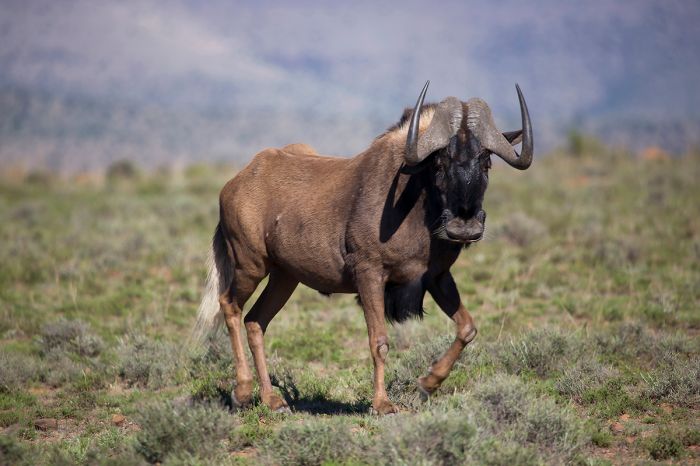
A specialty of the Eastern Cape reserves is the black wildebeest.
Kariega Game Reserve
Kariega covers 39 square miles (100 sq kms) of malaria-free safari country just a 10-minute drive inland from the small coastal town of Kenton-on-Sea. A farm in the region was purchased in 1989 and was converted back to its natural state with the dream of growing the small reserve. Over the next decade, numerous adjacent farms were purchased and the reserve grew in size. Today the reserve is large enough to support all of the Big Five animals as well as hippo, hyena, giraffe, wildebeest, kudu, waterbuck, and a variety of other herbivores.
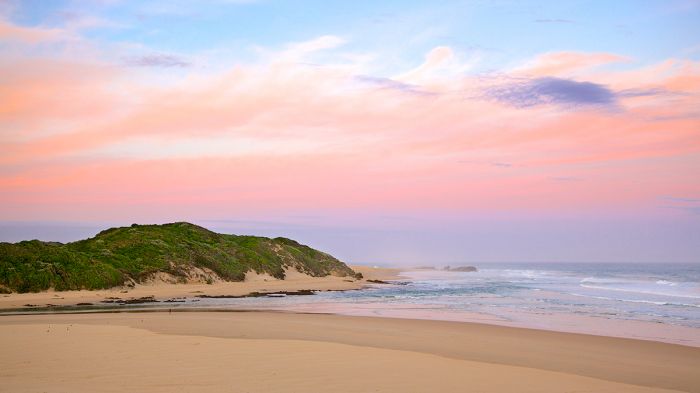
The Kariega river mouth at Kenton-on-Sea.
Kariega's wildlife is actively managed and the reserve is divided into two sections. The western side is much larger and has elephants and lion, with lower overall wildlife densities. The eastern side has no lion nor elephant and very few buffalo, but plenty of general herbivores, so walking safaris are safely conducted on this side.
Numerous lodges are on offer at Kariega, including Main Lodge (the first to be opened), which is the most economical and family-friendly. Homestead is a restored 1908 farmhouse booked mainly for exclusive use.
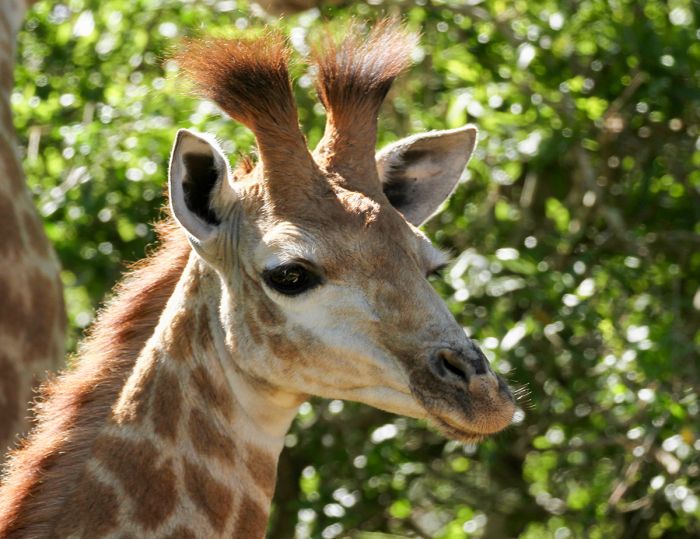
Baby giraffe in the Kariega Game Reserve.
Pumba Game Reserve
Pumba is a 27-square-mile (70-sq-km) malaria-free wildlife reserve located just northeast of Kariega and less than an hour's drive from Port Elizabeth. The reserve is best known for its self-sustaining population of white lions, which were first introduced to Pumba in 2004. All of Africa's Big Five (lion, leopard, elephant, buffalo, rhino) are here, as well as cheetah, spotted hyena, giraffe, zebra, hippo, warthog, wildebeest and numerous other mammals. Bird life is abundant and diverse as well.
Pumba offers two excellent safari lodges, with game drives (night drives too), walking safaris, birding safaris, and fishing. Day safaris are also offered for those who don't have time to spend the night. Pumba's Social Responsibility and Conservation Foundation supports the surrounding communities via employments, conservation education, and social upliftment.
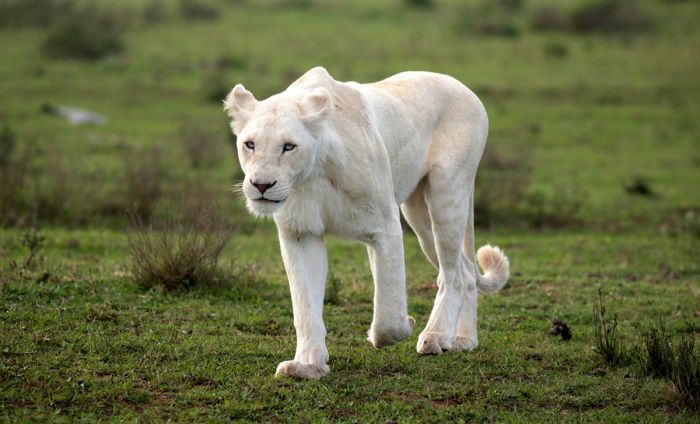
One of Pumba's white lions.
Sibuya Game Reserve
Sibuya is a 12-square-mile (30-sq-km), malaria-free wildlife reserve which shares a border with Kariega. Guests are transported to the reserve from the coastal town of Kenton-on-Sea up the Kariega River to one of two lodges. A third, more luxurious lodge is located just outside the reserve.
Wildlife is diverse and includes the Big Five, plus giraffe, zebra, eland, jackal, bontebok and more. Birding is excellent. Activities include game drives, birding, fishing, river boating and canoeing. Optional trips to the ocean for fly fishing, horseback riding, and swimming are also offered.
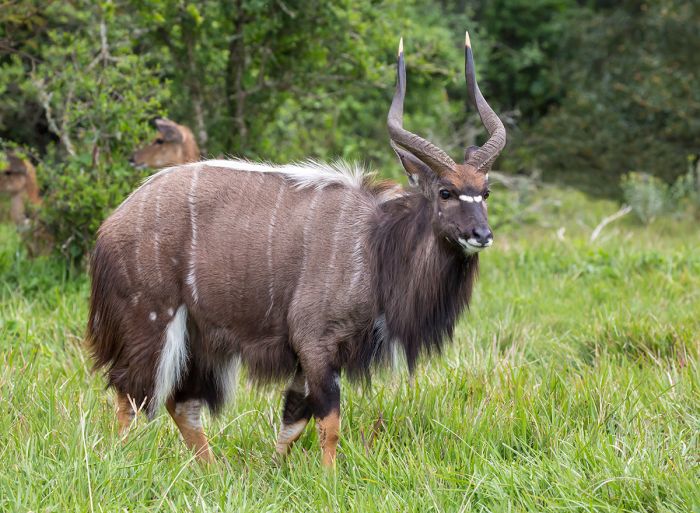
A male nyala in the Sibuya Game Reserve.
Grahamstown
This historic little town, with a very English feel to it, was thew site of several battles in the last two centuries. It was established as a garrison for the British on the eastern border of its Cape Colony and its well-preserved architecture is a reminder of its colonial past.
Grahamstown is dominated by private boarding schools, Georgian and Victorian buildings, its impressive cathedral, and Rhodes University. Every year during July, the annual 10-day National Arts Festival takes place here, with food, music, drama, and art events. The town is definitely worth visiting to see its historic sights and perhaps take a guided tour.
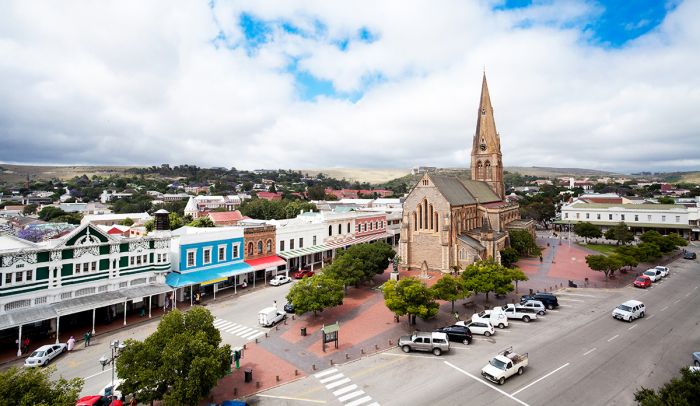
View over Grahamstown showing the cathedral.
Read More...
Addo Elephant Park, Amakhala, Eastern Cape Reserves, Grahamstown, Kariega, Kwandwe, Lalibela, Port Elizabeth, Pumba, Shamwari, Sibuya
Great Good Fair Poor
- Jan
- Feb
- Mar
- Apr
- May
- Jun
- Jul
- Aug
- Sep
- Oct
- Nov
- Dec
Port Elizabeth and the Coast
The Eastern Cape coast has a less defined seasonal climate than most of the country. Winters and summers along the coast are much less distinct in terms of rainfall and temperature.
Generally, the best weather along the coast occurs between August and early May. Rainy weather can occur throughout the year, although it often occurs at night.
Further inland, the typical South African seasonality means that the winter months (June thru September) can get quite chilly, while the coastal area remains warm and comfortable.
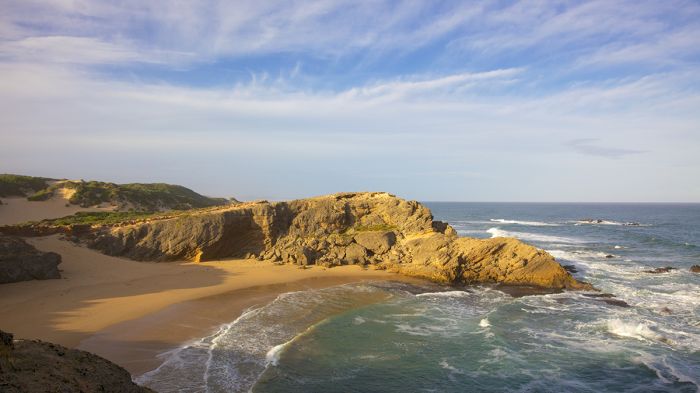
Shelly Bay at Kenton-on-Sea.
INLAND AND GAME RESERVES
Game viewing in the Eastern Cape Reserves is good year-round.
This said, like most of southern Africa, the winter months of June thru September are the driest and animals will spend more time near permanent water sources at this time, making game viewing a bit better. Rainfall is only slightly higher during the summer, but monthly rainfall is fairly steady throughout the year at around 1-2 inches per month.
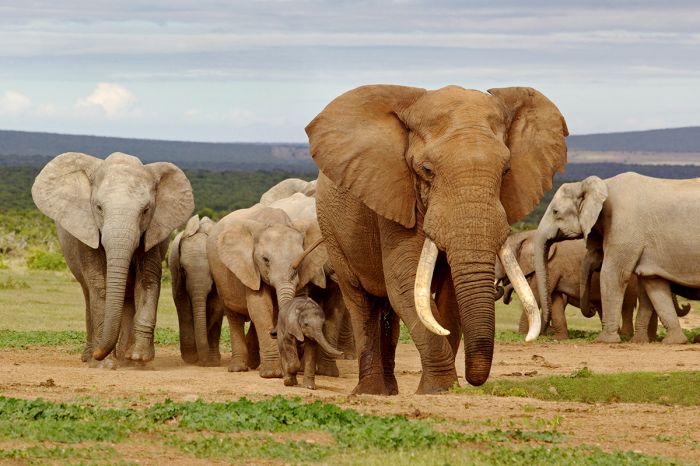
A magnificent bull elephant followed by a herd in Addo Elephant National Park.
Game drives during the winter, especially in the open vehicles used here, can be very chilly in the mornings and warm layered cloths are needed. Morning temps in winter average 43-46°F (6-8°C) while afternoon temps average 68-73°F (20-23°C).
The summer months (October thru April) experience very comfortable temperatures and only slightly more rain than the winter. Morning temps average 54-61°F (12-16°C), while afternoon temps reach 77-84°F (25-29°C). December thru February are the warmest months. March is typically the wettest month, but it rarely rains a lot or for very long.
High season in the reserves is October thru April and rates are higher at this time. Low season is May thru September.
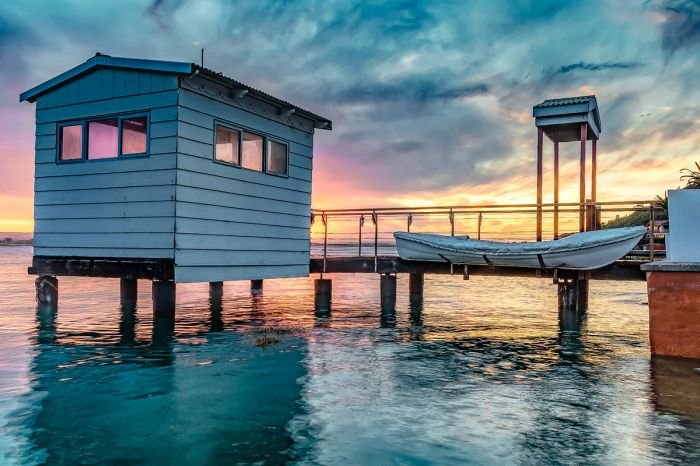
A boathouse on the Swartkops river near Port Elizabeth.




